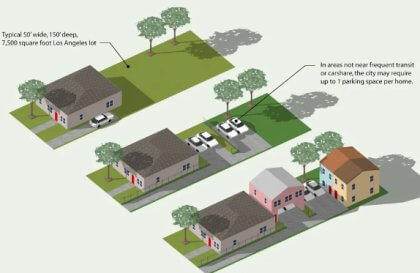Continuing a discussion from an earlier meeting, Sonoma’s Planning Commission will consider the impact of SB9 on residential lots at a special meeting on August 6, beginning at 6 p.m. in the City Council meeting room.

An illustration of the potential effect of SB9
SB9, the California Home Act, is a housing and land-use measure passed by the state legislature in 2022 that permits the division of residential lots into two, construction of up two units on each of the subdivided lots, and sale of the subdivided lot. Are you able to split your lot, build a two duplexes, and sell them? The answer is maybe “yes,” and maybe “no.”
The question before the Planning Commission is how SB9 applies to the City of Sonoma’s residential zoning districts. At present, the position of the City’s Development Director Jennifer Gates is that the only residential zones to which SB9 applies are Sonoma’s Rural Residential and Hillside zones. The vast bulk of Sonoma’s homes are located in Low-Density Zones, which Gates says are exempt from SB9 because the Low-Density Zones already allow duplexes, which she says is a form of multi-family development. SB9 does not apply to multi-family development zones, only so-called single-family zones. The commission will receive a legal analysis from its land use attorney.
According to the legislature, SB9 is intended to relieve California’s housing crisis by increasing development potential. The brainchild of San Francisco’s state senator Scott Weiner, who has generated much of the recent housing legislation passed during the past several years and signed into law by the Governor, if SB9 does indeed apply to low-density housing zones such as exist in Sonoma, it is potentially transformational.
Under SB9, where today a single family home exists in an “urban” area on a standard-sized parcel, as many as four homes can be built, with obvious effects of increased density on parking, traffic, noise, sewer plant capacity, and so forth. The effect on neighborhood home values is impossible to determine. The theory of SB9 is that additional housing development will produce lower-cost housing, but the state measure includes no requirements for affordability; in fact, it prohibits controls on prices or rental cost.
To make matters more complicated, provisions and definitions within SB9 and regulations produced by the State’s Housing Authority (HCD) are in conflict with each other, making some provisions of SB9 ambiguous. Matters such as the definition of “multi-family” need to be clarified and resolved, and ultimately it may fall to California’s courts to do so as a result of a legal challenge brought in a jurisdiction.
The City of Sonoma passed an emergency ordinance to respond to SB9 not long after it was adopted into law covering size, height, mass, and affordability, and it is that ordinance and its final form that will be a part of the discussion to take place. The recommendation of the commission on the form of a final ordinance that would be approved by the City Council will be the outcome of these discussions.





Was there any movement forward on this? still under discussion?
Yes, still under discussion.